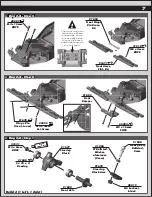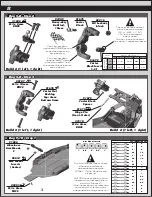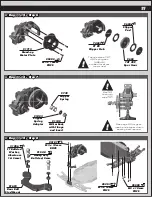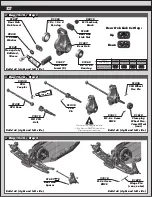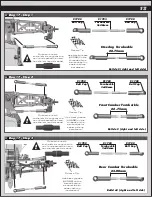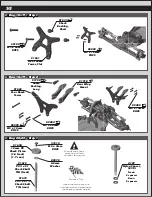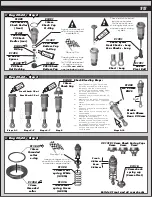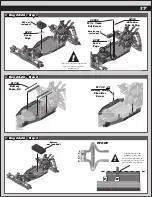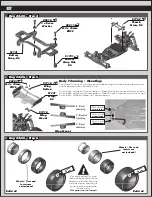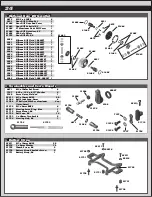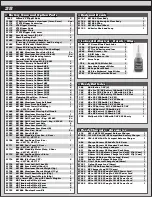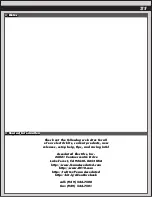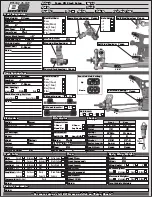
21
Rear Camber Link:
Changing the length of the camber link is considered a bigger step than adjusting
the ball end height on the rear chassis brace. Shortening the camber link
(or lowering the ball end) will give the rear end less roll and the car will tend to
accelerate or “square up” better. Lengthening the camber link (or raising the ball
end) will give the rear more roll and more cornering grip. Longer camber links are
typically used on high grip tracks, while shorter links tend to work better on
medium grip loose tracks. The kit setting is the best compromise of cornering grip
and acceleration.
*Raise or lower
the ball end by
adding or
removing
washers here
!
:: Tuning Tips (cont.)
Ride Height:
Ride height is the distance from the ground to the bottom of the chassis.
The standard front ride height setting is 23mm (Ride Height Gauge #1449).
Check the front ride height by lifting up the entire car about 8-12 inches off the bench and dropping it. After the
suspension “settles” into place, measure ride height (Ride Height Gauge #1449). Raise or lower the shock collars as
necessary.
The rear ride height setting you should use most often is 23mm (Ride Height Gauge#1449).
Check the rear ride height by lifting up the entire car about 8-12 inches off the bench and drop it. After the suspension
“settles” into place, measure ride height (Ride Height Gauge #1449). Raise or lower the shock collars as necessary.
Wheelbase Adjustment:
You have three options for rear hub spacing, Forward, Middle, & Back. The kit
setting of Middle is the most neutral, and will be used most often. For improved
handling in bumps or rhythm sections, try moving the hubs to the Back position.
Hub forward is typically used on low grip or where there are lots of tight corners.
*Spacers to the rear
will place hubs
forward, shortening
the wheelbase
!
Ackermann:
Ackermann is the angle difference between the front wheels when they are turned to steer the car. For minimal tire
slip, it is standard for the inside wheel to steer to a greater angle than the outside wheel. The B6 allows Ackermann
adjustments by changing the washer thickness used behind the steering rack ballstuds. The kit setup uses 2mm
washers and is most common for racing conditions. If corner entry steering is too aggressive, try increasing the
Ackermann by removing shims from behind the steering rack ballstuds. Increasing the Ackermann will increase the
angle difference of the front wheels when steered, resulting in a more stable car on corner entry.
Shock Mounting Position:
There are two positions for mounting the rear shocks. Mounting the shocks on the front of the arm reduces rear
weight bias. This causes the car to turn quicker and also steer more on-power. Usually this is used on high bite tracks in
order to keep the car steering while applying throttle. Front mounted shocks can only be used with the #91708
lay-down gear box. Mounting the shocks on the rear of the arm increases rear weight bias and keeps the rear end
planted while making the steering radius larger. This setting is typically easier to drive and will produce more rear
traction and can be used with any gear box configuration.
Axle Height:
Axle height is used to keep roll centers similar when large ride height changes are made. As a rule of thumb, high axle
heights are used for lower ride heights (< 20mm) and low axle heights are used for higher (> 22mm) ride heights. The
idea is to keep the arms close to level at ride height.
Anti-Roll Bars:
The optional #91735 and 91736 anti-roll bar kits (also called the “swaybar”) allows you to add roll resistance to the
front and /or rear end with minimal effect on handling over bumps and jumps. It is an especially helpful tuning item on
high-grip tracks.
Kickup:
Kickup is the angle the front suspension arm mounts at where the front of the arm is higher than the rear.
The standard kickup angle for the B6 is 25
°
, and is most common. If more corner entry steering is desired, try the
included 30
°
front bulkhead.
Summary of Contents for RC10B6D Team Kit
Page 1: ... 90012 RC10B6D Team Kit ...

